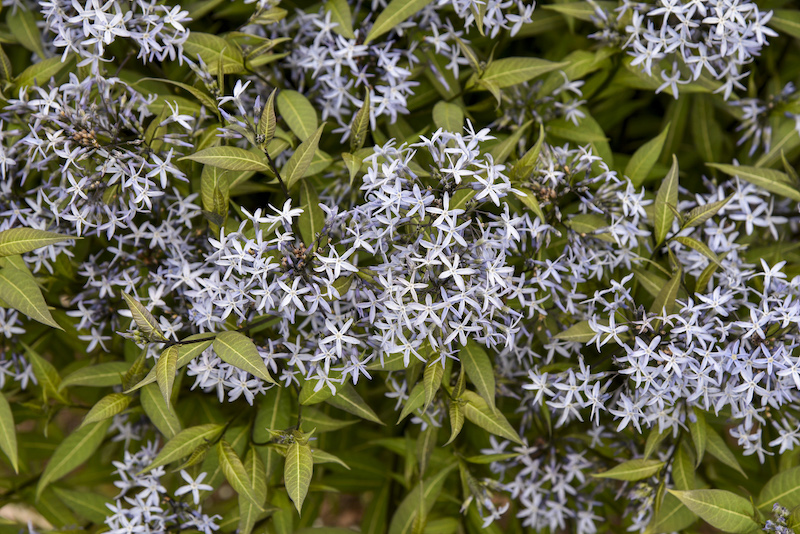Trouble-free perennials are highly sought after for low-maintenance garden designs. Amsonia is one herbaceous perennial that is dependably pest- and disease-free. Its resistance to most bacterial and fungal plant diseases is remarkable and one reason that this North American native plant continues to be very popular to grow for not only a display of spring flowers but an explosion of color in the autumn that can rival even the brightest maple trees.
Only two fungal diseases are known to be issues for Amsonia: Mycosphaerella leaf spot and rust. These diseases are more likely to attack during periods of mild and humid weather, such as in the late spring or late summer months. The fungi are spread by the wind and water from overhead watering of plants or natural rain.

Mycosphaerella Leaf Spot
Leaf spot is caused by a fungus that can be active as early as spring if the weather conditions are conducive. Warm, humid days and nights help the fungus to spread efficiently. Often only the foliage is affected, causing premature leaf drop. When a leaf spot attacks an edible crop, it will also reduce the fruit size and crop yield. Because Amsonia is an ornamental perennial plant, only the current year's flowers and foliage will be affected.
Identifying Mycosphaerella Leaf Spot
Small, dark-colored spots appear mainly at the tips of the leaves and may spread near the veins. Over time, the whole leaf will be covered in angular dark spots and will begin to yellow; eventually, the leaves will fall off prematurely, and the plant's overall growth will decline.
Treating Mycosphaerella Leaf Spot
The best treatment for leaf spot in the home garden is to remove all infected parts and keep the foliage as dry as possible. Overhead watering of Amsonia will spread the fungal spores quickly to other healthy parts of the plant. Remove any fallen foliage promptly so that the spores cannot overwinter in leaf litter. Cut back affected plants at the end of the growing season and dispose of the top growth in the trash.
Rust
Fungal rust infections are more likely to happen while daytime temperatures are moderate and humidity is high. Spring and late summer are commonly when rust develops on plants. Rust early in the growing season is more likely to affect the overall growth of a plant, causing it to be stunted or fail to thrive. Rust occurring late in the summer is easily managed on herbaceous perennials like Amsonia because the plants will be dying back soon for winter dormancy anyway. Any affected foliage and stems will die over winter, and the plant will regrow the following season.
Identifying Rust
Fungal rust looks exactly what it sounds like. Spots of yellow, orange, or reddish-orange will begin to appear on the oldest growth first. Over the course of a few days, the spots of fungal spores will get larger and spread to newer foliage. The leaves will start to yellow also and start to die back.
Treating Rust
Rust-affected plant parts should be removed and disposed of. There are fungicides that protect the healthy parts of the plant. Follow the manufacturer's instructions and ensure that the spray you are using is safe to use on Amsonia. Rust overwinters in the soil on infected leaf litter. Cut back all plant parts at the end of the growing season and dispose of them in the trash. Avoid wetting the foliage with overhead watering, and instead use drip irrigation or soaker hoses.
Amsonia Disease Chart
|
Disease |
Identifying |
Treating |
|
Mycosphaerella leaf spot |
Dark brown or black spots on leaves or flowers |
Remove infected parts of the plant, apply fungicide to protect uninfected parts of the plant |
|
Rust |
Yellow, orange, or red spots on leaves |
Remove infected plant material, avoid overhead watering |
Sources:
"Blue Star (Amsonia)." Crow Wing Master Gardeners. crowwingmastergardeners.org
"Willow Blue Star." Cornell University. gardening.cornell.edu
 |
Author Robbin Small - Published 6-07-2023 |
